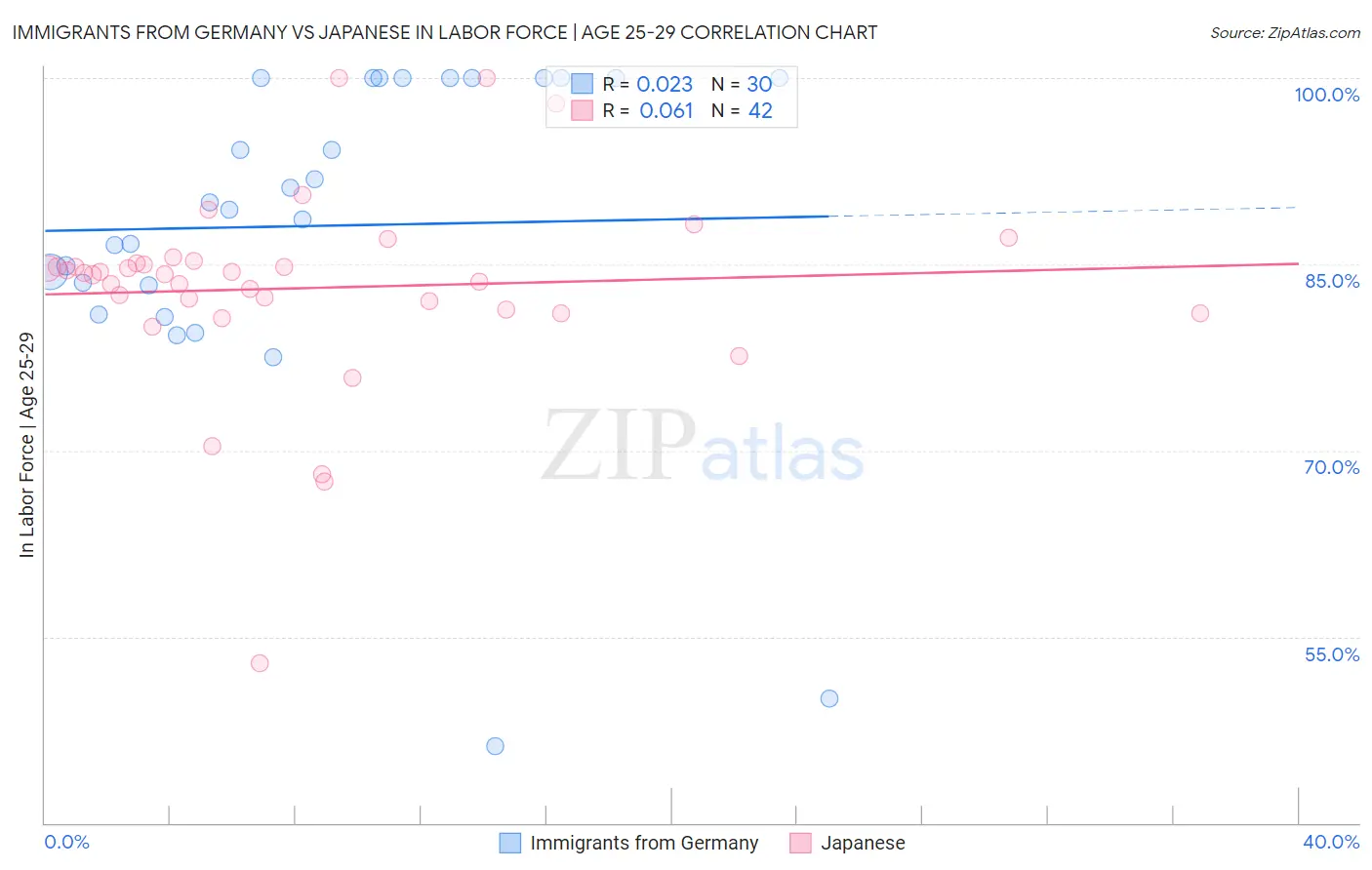Immigrants from Germany vs Japanese In Labor Force | Age 25-29
COMPARE
Immigrants from Germany
Japanese
In Labor Force | Age 25-29
In Labor Force | Age 25-29 Comparison
Immigrants from Germany
Japanese
84.4%
IN LABOR FORCE | AGE 25-29
18.3/ 100
METRIC RATING
199th/ 347
METRIC RANK
84.3%
IN LABOR FORCE | AGE 25-29
11.4/ 100
METRIC RATING
213th/ 347
METRIC RANK
Immigrants from Germany vs Japanese In Labor Force | Age 25-29 Correlation Chart
The statistical analysis conducted on geographies consisting of 463,583,295 people shows no correlation between the proportion of Immigrants from Germany and labor force participation rate among population between the ages 25 and 29 in the United States with a correlation coefficient (R) of 0.023 and weighted average of 84.4%. Similarly, the statistical analysis conducted on geographies consisting of 249,141,498 people shows a slight positive correlation between the proportion of Japanese and labor force participation rate among population between the ages 25 and 29 in the United States with a correlation coefficient (R) of 0.061 and weighted average of 84.3%, a difference of 0.10%.

In Labor Force | Age 25-29 Correlation Summary
| Measurement | Immigrants from Germany | Japanese |
| Minimum | 46.2% | 52.9% |
| Maximum | 100.0% | 100.0% |
| Range | 53.8% | 47.1% |
| Mean | 88.1% | 83.1% |
| Median | 89.7% | 84.3% |
| Interquartile 25% (IQ1) | 83.3% | 81.3% |
| Interquartile 75% (IQ3) | 100.0% | 85.1% |
| Interquartile Range (IQR) | 16.7% | 3.8% |
| Standard Deviation (Sample) | 13.4% | 8.0% |
| Standard Deviation (Population) | 13.1% | 7.9% |
Demographics Similar to Immigrants from Germany and Japanese by In Labor Force | Age 25-29
In terms of in labor force | age 25-29, the demographic groups most similar to Immigrants from Germany are Immigrants from South Eastern Asia (84.4%, a difference of 0.010%), Tlingit-Haida (84.4%, a difference of 0.010%), Immigrants from Iraq (84.4%, a difference of 0.010%), Immigrants from Kazakhstan (84.4%, a difference of 0.010%), and Laotian (84.4%, a difference of 0.020%). Similarly, the demographic groups most similar to Japanese are Subsaharan African (84.3%, a difference of 0.0%), Lebanese (84.3%, a difference of 0.010%), Immigrants from Syria (84.3%, a difference of 0.010%), Immigrants from Jordan (84.4%, a difference of 0.020%), and Chinese (84.3%, a difference of 0.020%).
| Demographics | Rating | Rank | In Labor Force | Age 25-29 |
| Immigrants | South Eastern Asia | 19.5 /100 | #196 | Poor 84.4% |
| Tlingit-Haida | 19.3 /100 | #197 | Poor 84.4% |
| Immigrants | Iraq | 19.0 /100 | #198 | Poor 84.4% |
| Immigrants | Germany | 18.3 /100 | #199 | Poor 84.4% |
| Immigrants | Kazakhstan | 17.5 /100 | #200 | Poor 84.4% |
| Laotians | 16.6 /100 | #201 | Poor 84.4% |
| Afghans | 15.9 /100 | #202 | Poor 84.4% |
| Immigrants | Afghanistan | 15.6 /100 | #203 | Poor 84.4% |
| Venezuelans | 15.1 /100 | #204 | Poor 84.4% |
| Ecuadorians | 14.8 /100 | #205 | Poor 84.4% |
| Immigrants | Cambodia | 14.3 /100 | #206 | Poor 84.4% |
| Immigrants | Armenia | 13.3 /100 | #207 | Poor 84.4% |
| Immigrants | Indonesia | 13.2 /100 | #208 | Poor 84.4% |
| Immigrants | Jordan | 12.8 /100 | #209 | Poor 84.4% |
| Chinese | 12.7 /100 | #210 | Poor 84.3% |
| Immigrants | Venezuela | 12.6 /100 | #211 | Poor 84.3% |
| Sub-Saharan Africans | 11.7 /100 | #212 | Poor 84.3% |
| Japanese | 11.4 /100 | #213 | Poor 84.3% |
| Lebanese | 11.1 /100 | #214 | Poor 84.3% |
| Immigrants | Syria | 10.7 /100 | #215 | Poor 84.3% |
| Israelis | 9.3 /100 | #216 | Tragic 84.3% |